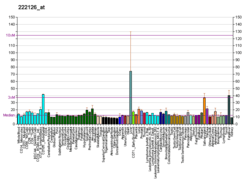Arf-GAP domain and FG repeats-containing protein 2 is a protein that in humans is encoded by the AGFG2 gene.[5][6]
This gene is a member of the HIV-1 Rev binding protein (HRB) family and encodes a protein with one Arf-GAP zinc finger domain, several phe-gly (FG) motifs, and four asn-pro-phe (NPF) motifs. This protein interacts with Eps15 homology (EH) domains and plays a role in the Rev export pathway, which mediates the nucleocytoplasmic transfer of proteins and RNAs. Alternatively spliced variants which encode different protein isoforms have been described; however, not all variants have been fully characterized.[6]
Further reading
- Wong WT, Schumacher C, Salcini AE, et al. (1995). "A protein-binding domain, EH, identified in the receptor tyrosine kinase substrate Eps15 and conserved in evolution". Proc. Natl. Acad. Sci. U.S.A. 92 (21): 9530–4. doi:10.1073/pnas.92.21.9530. PMC 40835. PMID 7568168.
- Bonaldo MF, Lennon G, Soares MB (1997). "Normalization and subtraction: two approaches to facilitate gene discovery". Genome Res. 6 (9): 791–806. doi:10.1101/gr.6.9.791. PMID 8889548.
- Salcini AE, Confalonieri S, Doria M, et al. (1997). "Binding specificity and in vivo targets of the EH domain, a novel protein-protein interaction module". Genes Dev. 11 (17): 2239–49. doi:10.1101/gad.11.17.2239. PMC 275390. PMID 9303539.
- Doria M, Salcini AE, Colombo E, et al. (2000). "The eps15 homology (EH) domain-based interaction between eps15 and hrb connects the molecular machinery of endocytosis to that of nucleocytosolic transport". J. Cell Biol. 147 (7): 1379–84. doi:10.1083/jcb.147.7.1379. PMC 2174238. PMID 10613896.
- Strausberg RL, Feingold EA, Grouse LH, et al. (2003). "Generation and initial analysis of more than 15,000 full-length human and mouse cDNA sequences". Proc. Natl. Acad. Sci. U.S.A. 99 (26): 16899–903. doi:10.1073/pnas.242603899. PMC 139241. PMID 12477932.
- Scherer SW, Cheung J, MacDonald JR, et al. (2003). "Human chromosome 7: DNA sequence and biology". Science. 300 (5620): 767–72. doi:10.1126/science.1083423. PMC 2882961. PMID 12690205.
- Ota T, Suzuki Y, Nishikawa T, et al. (2004). "Complete sequencing and characterization of 21,243 full-length human cDNAs". Nat. Genet. 36 (1): 40–5. doi:10.1038/ng1285. PMID 14702039.
- Gerhard DS, Wagner L, Feingold EA, et al. (2004). "The status, quality, and expansion of the NIH full-length cDNA project: the Mammalian Gene Collection (MGC)". Genome Res. 14 (10B): 2121–7. doi:10.1101/gr.2596504. PMC 528928. PMID 15489334.





